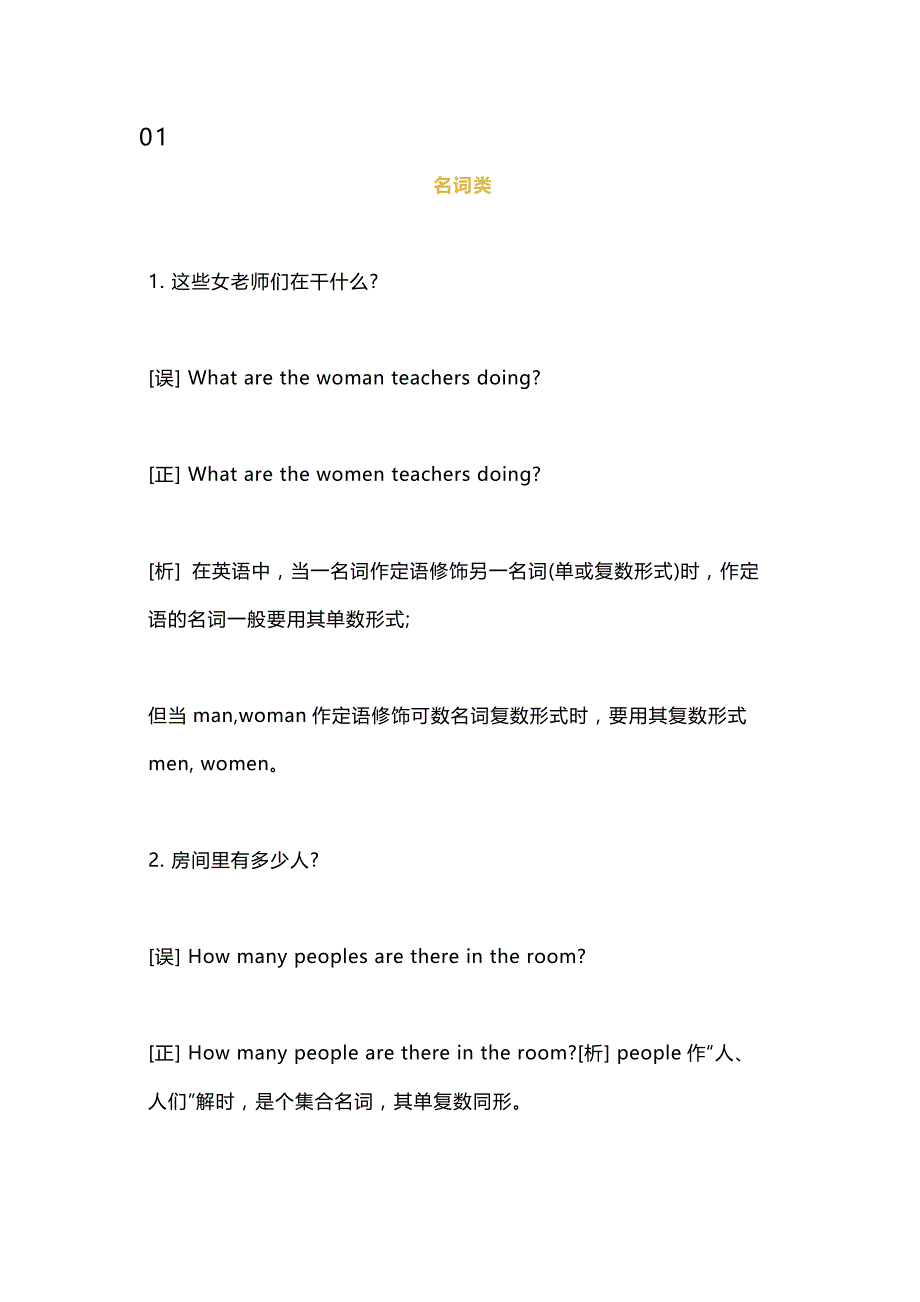《小學(xué)英語(yǔ)1-6年級(jí)八個(gè)易錯(cuò)知識(shí)點(diǎn)》由會(huì)員分享����,可在線閱讀,更多相關(guān)《小學(xué)英語(yǔ)1-6年級(jí)八個(gè)易錯(cuò)知識(shí)點(diǎn)(10頁(yè)珍藏版)》請(qǐng)?jiān)谘b配圖網(wǎng)上搜索�。
1、01
?名詞類(lèi)
1.?這些女老師們?cè)诟墒裁?
[誤]?What?are?the?woman?teachers?doing?
[正]?What?are?the?women?teachers?doing?
[析] 在英語(yǔ)中����,當(dāng)一名詞作定語(yǔ)修飾另一名詞(單或復(fù)數(shù)形式)時(shí),作定語(yǔ)的名詞一般要用其單數(shù)形式;
但當(dāng)man,woman作定語(yǔ)修飾可數(shù)名詞復(fù)數(shù)形式時(shí)��,要用其復(fù)數(shù)形式men, women�。
2.?房間里有多少人?
[誤]?How?many?peoples?are?there?in?the?room?
[正] How many people are
2、there in the room?[析] people作“人��、人們”解時(shí)��,是個(gè)集合名詞����,其單復(fù)數(shù)同形�。
3. 我想為我兒子買(mǎi)兩瓶牛奶���。
[誤] I want to buy two bottle of milk for my son.
[正] I want to buy two bottles of milk for my son.
[析] 表示不可數(shù)名詞的數(shù)量時(shí)����,常用“a / an或數(shù)詞+表量的可數(shù)名詞+ of + 不可數(shù)名詞”這一結(jié)構(gòu)�����,其中當(dāng)數(shù)詞大于1時(shí)�����,表量的可數(shù)名詞要用其復(fù)數(shù)形式���。
?
02
??動(dòng)詞類(lèi)
4.?你妹妹通常什么時(shí)候去上學(xué)?
3、
[誤]?What?time?does?your?sister?usually?goes?to?school?
[正]?What?time?does?your?sister?usually?go?to?school?
[析] 借助助動(dòng)詞do(或does)構(gòu)成疑問(wèn)句或否定句時(shí)���,句中的謂語(yǔ)動(dòng)詞用其原形�����。
5. 琳達(dá)晚上經(jīng)常做作業(yè)�����,但今晚她在看電視����。
[誤] Linda often do her homework in the evening, but this evening she watching TV.
[正] Linda often does her home
4、work in the evening, but this evening she is watching TV.
[析] 一般現(xiàn)在時(shí)表示經(jīng)常的或習(xí)慣性的動(dòng)作���,常和often, usually, sometimes 等時(shí)間狀語(yǔ)連用�����。
在一般現(xiàn)在時(shí)的句子中����,若主語(yǔ)是第三人稱單數(shù)���,謂語(yǔ)動(dòng)詞要用其第三人稱單數(shù)形式�����。
現(xiàn)在進(jìn)行時(shí)表示現(xiàn)階段正在進(jìn)行或發(fā)生的動(dòng)作�����,現(xiàn)在進(jìn)行時(shí)由be(am / is / are)+ving形式構(gòu)成���。
6. 這雙鞋是紅色的���。
[誤] This pair of shoes are red.
[正] This pair of shoes is r
5、ed.
[析] 在shoes, trousers, gloves, glasses等表示成雙成對(duì)的衣物或工具名詞前用pair(表計(jì)量)修飾時(shí)���,謂語(yǔ)動(dòng)詞的形式由pair的單復(fù)數(shù)形式來(lái)決定�����。
?
03
?代詞類(lèi)
7. 這張票是她的�����,不是我的。
[誤] This is hers ticket. It’s not my.
[正] This is her ticket. It’s not mine.
[析] 物主代詞有形容詞性物主代詞和名詞性物主代詞之分���。形容詞性物主代詞之后一定要接名詞���,而名詞性物主代詞之后不需接任何詞。
8. 吳老師教我們英語(yǔ)�����。
6、
[誤] Miss Wu teaches our English.
[正] Miss Wu teaches us English.
[析] teach sb. sth..中的sb.作teach的賓語(yǔ)���,因此當(dāng)sb.為人稱代詞時(shí)要用其賓格形式�����。
?
04
?介詞類(lèi)
9.?你能找到這個(gè)問(wèn)題的答案嗎?
[誤]?Can?you?find?the?answer?of?this?question?
[正]?Can?you?find?the?answer?to?this?question?
[析] 英語(yǔ)中用“the answer to …”表示“……的答案”����。
7���、類(lèi)似結(jié)構(gòu)還有the key to the door, the way to the zoo等�����。
10. 格林先生星期六上午來(lái)這里����。
[誤] Mr. Green will come here in Sunday evening.
[正] Mr. Green will come here on Sunday evening.
[析] 表示在上午����、下午等時(shí)��,介詞要用in�;而表示在具體的某天上午�����、下午時(shí)����,介詞要用on.
11. 那個(gè)穿著紅裙子的小女孩是我們老師的女兒。
[誤] That little girl on a red skirt is our teache
8���、r’s daughter.
[正] That little girl in a red skirt is our teacher’s daughter.
[析] 用介詞表示“穿戴衣物”時(shí)����,只能用in��,其他介詞沒(méi)有此用法�。
?
05
?副詞類(lèi)
12.?莉莉,你為什么不回家呢?
[誤]?Lily,?why?don’t?you?go?to?home?
[正]?Lily,?why?don’t?you?go?home?
[析] come, go 等后接here, there, home等地點(diǎn)副詞時(shí)���,地點(diǎn)副詞前不加to。
?
06
?連詞類(lèi)
9���、
13. 我喜歡語(yǔ)文和英語(yǔ)����,但我不喜歡體育和歷史。
[誤] I like Chinese and English, but I don’t like P.E. and history.
[正] I like Chinese and English, but I don’t like P.E. or history.
[析] 在肯定句中并列成分之間用and來(lái)連接;而在否定句中����,并列成分之間的連接需用or。
?
07
?冠詞類(lèi)
14. 乘飛機(jī)去北京花了史密斯一家人一個(gè)小時(shí)��。
[誤] It takes Smiths a hour to go to Be
10����、ijing by a plane.
[正] It takes the Smiths an hour to go to Beijing by plane.
[析]?1.表示“……一家人”用結(jié)構(gòu)“the + 姓氏復(fù)數(shù)”;
2.our 一詞的第一個(gè)字母不發(fā)音,它是以元音音素開(kāi)頭的�����,所以“一小時(shí)”要用 an hour;
3.用介詞by表示“乘坐”某種交通工具時(shí)�,交通工具名詞前不加任何冠詞。
?
08
?句法類(lèi)
15. ―你不是學(xué)生嗎??
―不�����,我是學(xué)生���。
[誤]?―Aren’t?you?a?student?
?―No�,?I?am.
[正]?―Aren’t?you?a?student?
?―Yes,?I?am.
[析] 對(duì)否定疑問(wèn)句的回答是用Yes還是用No��,這取決于實(shí)際情況:如果事實(shí)是肯定的�����,就用Yes表“不”;如果事實(shí)是否定的��,就用No表“是的”���。
16.?房間里有多少人?
[誤]?How?many?peoples?are?there?in?the?room?
[正]?How?many?people?are?there?in?the?room?
[析] people作“人����、人們”解時(shí)�,是個(gè)集合名詞,其單復(fù)數(shù)同形�。
 小學(xué)英語(yǔ)1-6年級(jí)八個(gè)易錯(cuò)知識(shí)點(diǎn)
小學(xué)英語(yǔ)1-6年級(jí)八個(gè)易錯(cuò)知識(shí)點(diǎn)

